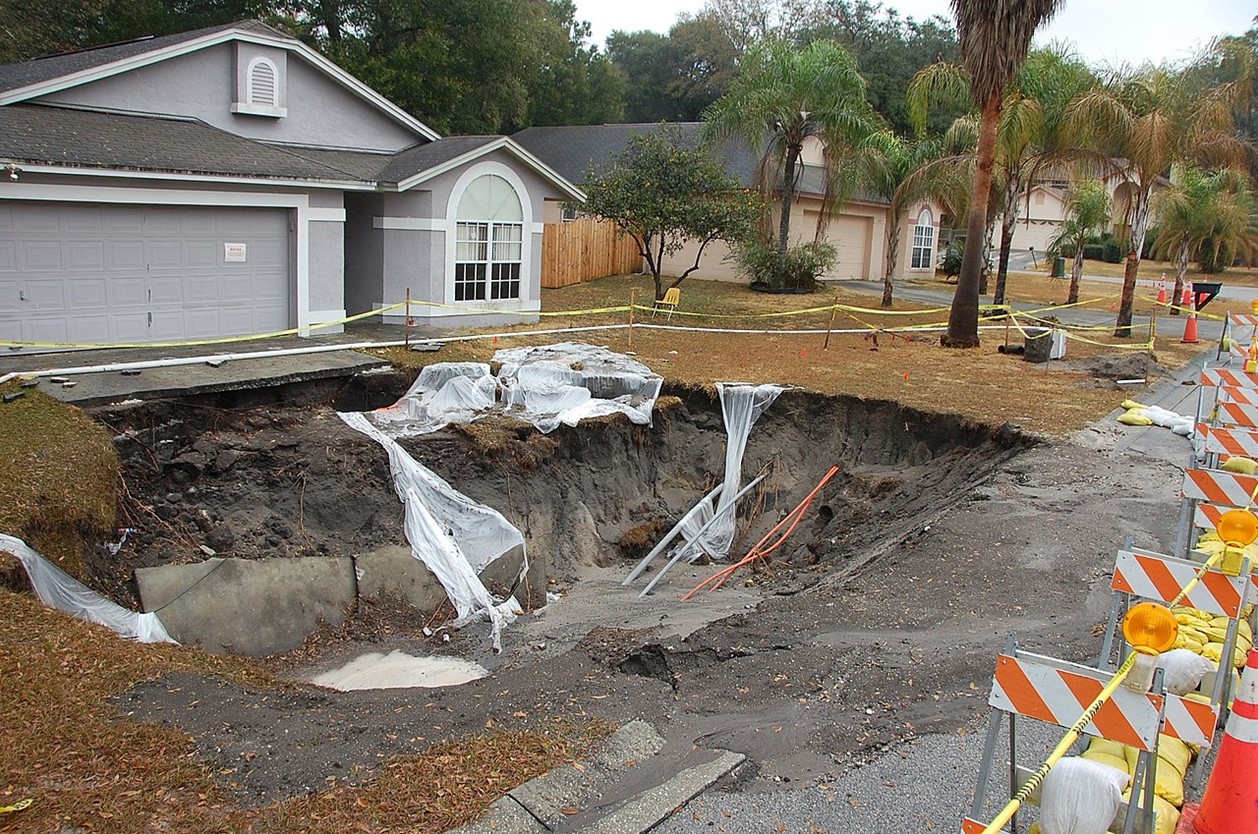
Credit: U.S. Geological Survey, CC0, via Wikimedia Commons
In China, sinkholes are called “heavenly pits.” And China has the largest one in the world, named Xiaozhai. It’s two thousand feet deep and just as wide.
Sinkholes occur where Earth’s surface collapses into an underground void. It could be sudden, when a giant hole opens in the ground. Or sinkholes can form slowly, making depressions in the landscape that appear as rolling hills and troughs.
Both are caused by water eroding or dissolving the bedrock.
This could happen over centuries, when rainfall mixes with plant material to form a weak carbonic acid and percolates into limestone, slowly dissolving it.
Or, if that underlying rock is an evaporite—like salt or gypsum—it can happen fast, in months or even days.
Especially if water flows through the rock. This might be from an underground river, which is what formed China’s Xiaozhai. Or from water leaking from human infrastructure, like a water main.
In the U.S., sinkholes occur in all 50 states and cause 300 million dollars in damage a year. But they also form lakes and provide access to underground caverns.
If you ever visit China, you can take the half-mile staircase down into Xiaozhai, where there are more than a thousand rare animal species.
The river still flows beneath this massive depression, though, so be warned, the story may not yet be over.
Background
Synopsis: While moving water is a major agent of surface erosion, moving groundwater also causes erosion underground, especially in soluble bedrocks like limestone and evaporites. Underground voids, including caves, may gradually or suddenly develop into sinkholes if their roofs collapse. Many sinkholes are caused by water damage from human infrastructure. Sinkholes form in all 50 states, and over the past 15 years have caused at least $300 million in damages in the United States.
- Water is a powerful erosional agent on Earth’s surface, but in areas with soluble bedrock, it can both chemically dissolve and physically erode rocks underground to produce what is known as karst topography, which includes both caves and hazardous sinkholes.
- Limestones and dolomites are soluble in slightly acidic water but may take centuries to millennia to produce underground karst cavities and systems.
- Evaporites like halite (salt), anhydrite and gypsum are even more water soluble. Flowing water in these units can create cavities in days to years, sometimes known as pseudokarst.
- Water movement at the periphery of these units may mobilize less-soluble adjacent sediments, further undermining the ground surface.
- Sinkholes are closed depressions that drain into the subsurface, eventually filling with water to the level of the water table or higher if their underground outlets become plugged.
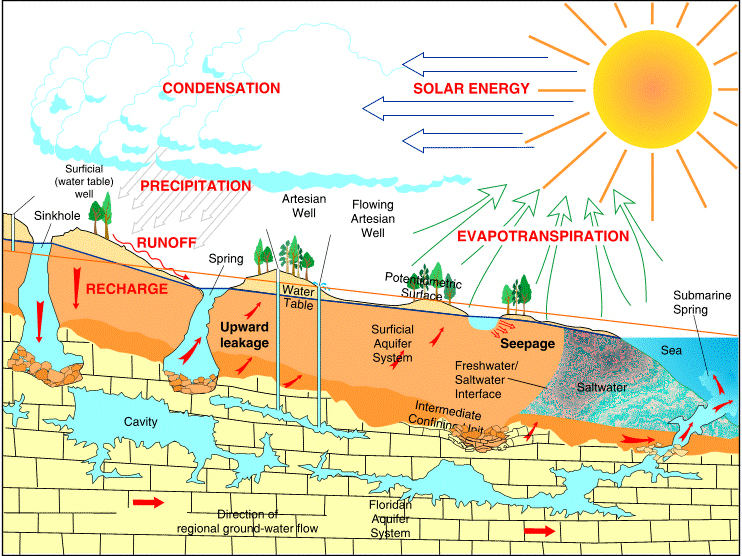
Sinkholes form as part of a region’s hydrological system. The U.S. state of Florida’s geology makes it especially prone to the development of sinkholes, as shown in this cartoon illustrating the relationship among sinkholes, artesian wells, and springs within the Florida aquifer system.
Credit: USGS
- Sinkholes may form gradually as the ground subsides over a developing underground void, or they may form suddenly if a void’s roof collapses. There are three main types of sinkholes:
- Dissolution sinkholes tend to form along fractures and bedding planes in soluble bedrock, especially where groundwater is in contact with air. As rainfall and surface water percolate into the rock, mixing with organics and becoming a weak carbonic acid, the rock dissolves, leaving a depression that collects water and accelerates dissolution to leave gently rolling hills.
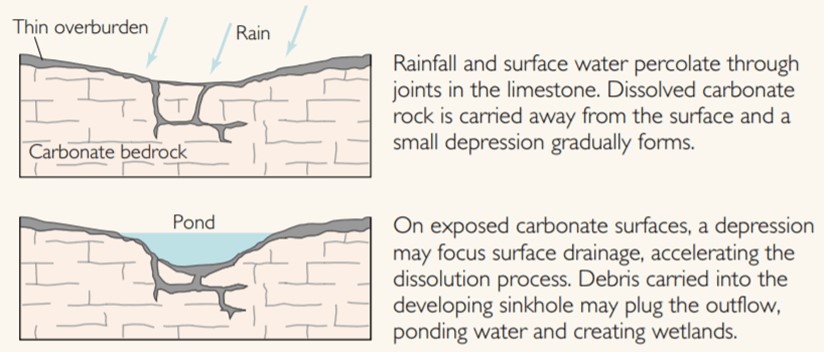
Credit: Land Subsidence in the United States, USGS - Cover-subsidence sinkholes develop where the sediments covering a soluble unit are permeable, especially if they contain sand. Thicker or finer-grained overlying units slow the process, requiring longer periods of time for subsidence.

Credit: Land Subsidence in the United States, USGS - Cover-collapse sinkholes may cause catastrophic damage as they develop abruptly once the overlying sediments can no longer support the weight of the rocks between the ground surface and the roof of the cavity. This often occurs when the overlying sediments are clay rich. Sudden drops in the water table may trigger collapse as air replaces water in the void.

Credit: Land Subsidence in the United States, USGS
- Dissolution sinkholes tend to form along fractures and bedding planes in soluble bedrock, especially where groundwater is in contact with air. As rainfall and surface water percolate into the rock, mixing with organics and becoming a weak carbonic acid, the rock dissolves, leaving a depression that collects water and accelerates dissolution to leave gently rolling hills.
- Sinkholes can be caused by human activity.
- Pore water within sediments and cavities helps to support the ground surface.
- Fluid pressures underground are delicately balanced in nature to support the overlying ground surface.
- Human alteration of subsurface pressures occurs during removal of groundwater as well as when loading of the land surface (overburden pressure) is changed.
- Accidental water flow along infrastructure may also create voids that can cause cover collapse.
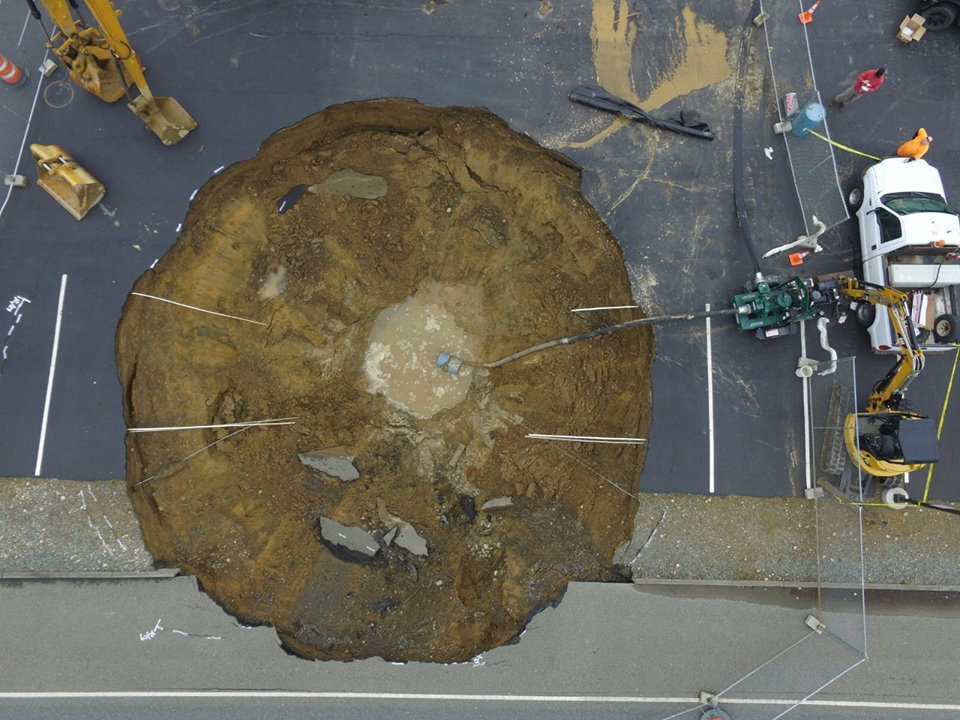
A massive sinkhole opened up on U.S. Route 101 near the coastal town of Harbor, Oregon, in January 2016. Water infrastructure is often installed under impermeable roads, so flooding or leakages may create voids that cause catastrophic collapses of road surfaces.
Credit: Oregon Department of Transportation, CC BY 2.0, via Wikimedia Commons
- Much of the United States is underlain by soluble bedrock, and sinkholes have been documented in all 50 states.
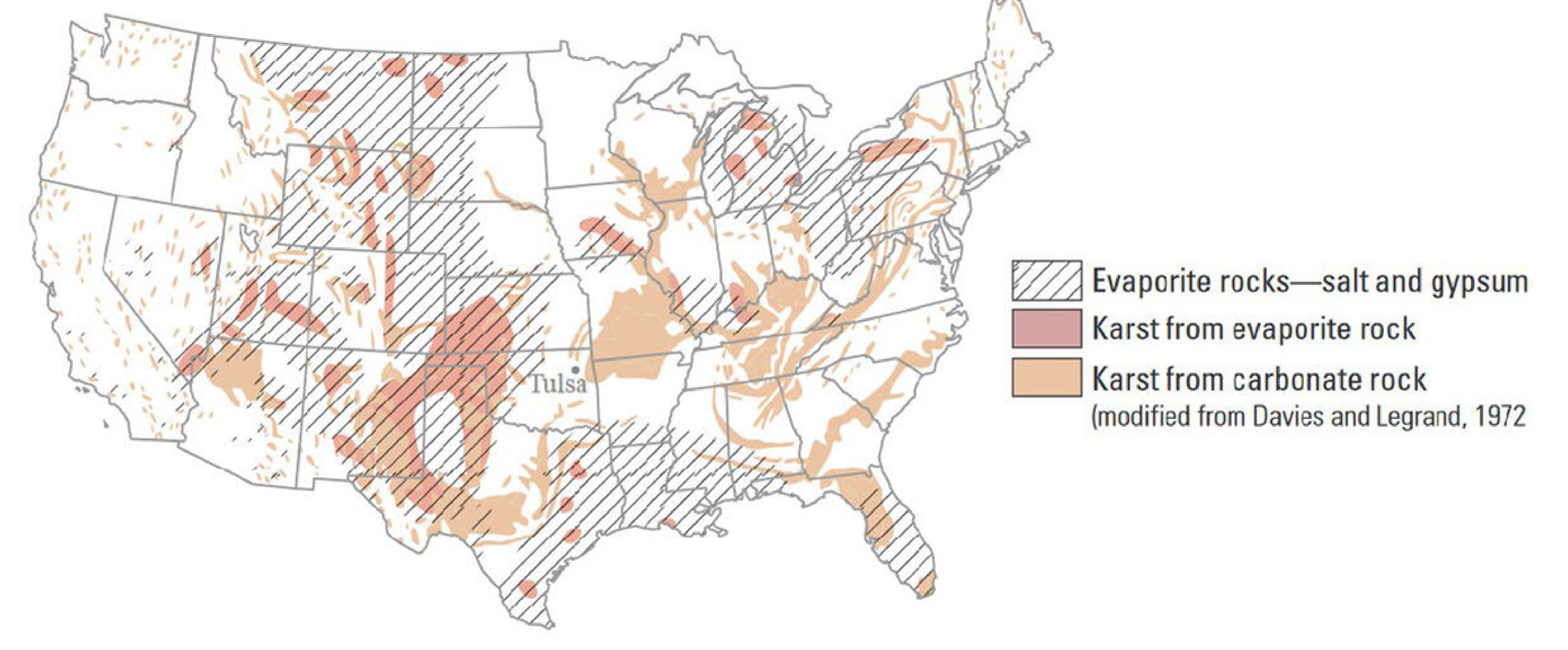
Map showing the extent of soluble bedrock in the contiguous United States.
Credit: USGS Fact Sheet 165-00- Soluble bedrock is common all over the globe, with major karst development apparent at the surface of every continent except Antarctica.
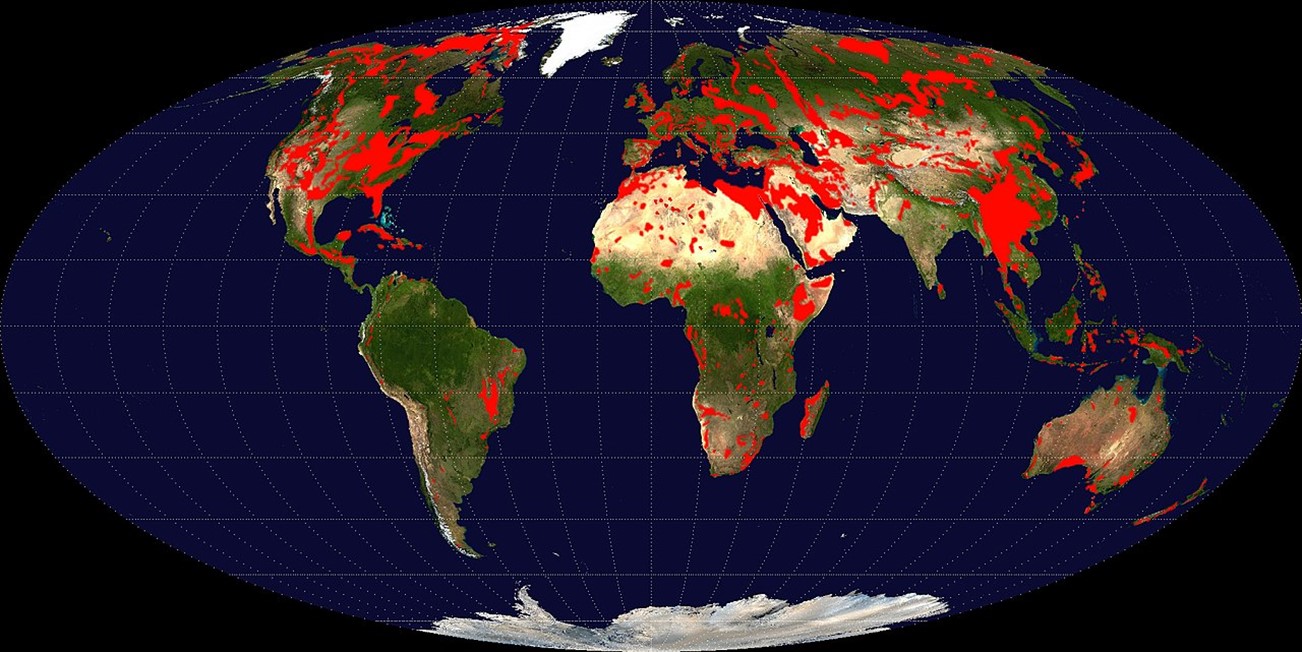
Global occurrence of carbonate bedrock that may be karstified.
Credit: ulrichstill, CC BY-SA 2.0 DE, via Wikimedia Commons
- Soluble bedrock is common all over the globe, with major karst development apparent at the surface of every continent except Antarctica.
- Estimates from 2016 suggest that at least $300 million in damages is incurred each year in the United States from karst subsidence and sinkhole collapse.
- Because there is no comprehensive database of these hazards, researchers believe this is an underestimation.
- A 2023 publication has finally quantified sinkhole susceptibility for the United States with useful maps and databases by county.
- While every state in the “lower 48” states have sinkhole susceptibility, the leading hot spots for sinkhole development are in Kentucky, Tennessee, Missouri and north-central Florida, followed closely by Texas, Alabama and Pennsylvania.
- Underground cavities that might become sinkholes can be surveyed using ground-penetrating radar, but first someone has to suspect a cavity exists.
Here are a few examples of natural and human-induced sinkholes.
- Earth’s largest natural sinkhole, the Xiaozhai Tiankeng, formed in in the Chongqing municipality of China when the roof of a subterranean river cavern collapsed long ago in the native limestones of the region.
- Chinese sinkholes are called “heavenly pits” or “tiankeng.”
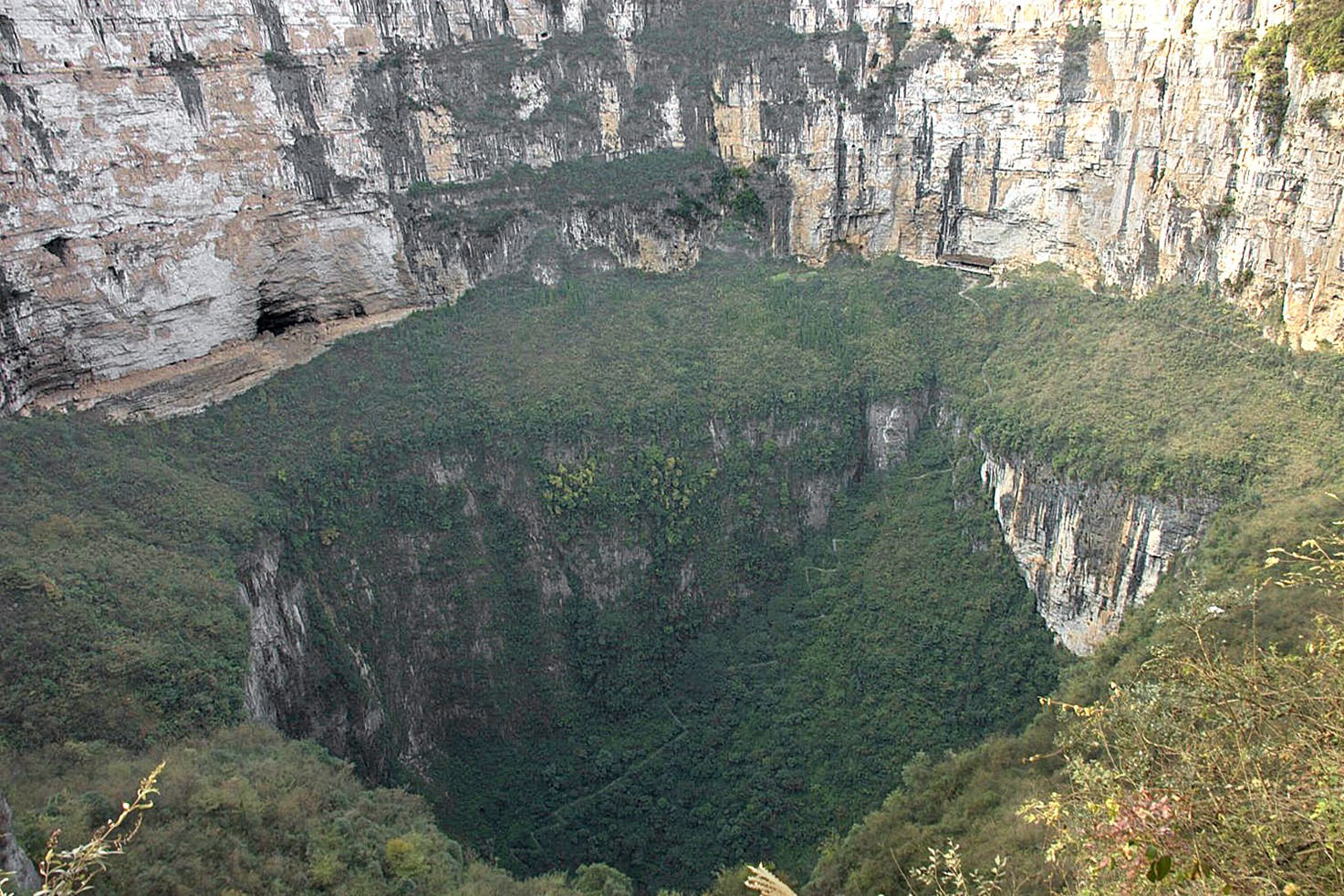
Mapped in 1994, the Xiaozhai Tiankeng is a doubly nested collapse that reaches a total of 2,172 ft (662 m) at its deepest point. The upper bowl is 1,050 ft (320 m) deep and about 1,968 ft (600 m) in diameter, while the lower hollow is 1,122 ft (342 m) deep and around 850 ft (260 m) across. It is surrounded by vertical cliffs except where a fan of collapse debris provides tourist access via a 2,800-step staircase that is barely visible in the photo.
Credit: Brookqi, public domain, via Wikimedia Commons - More than 1,285 species of plants and many rare animals like the clouded leopard and Chinese giant salamander have been found in the sinkhole.
- The river still flows under the sinkhole, so this story may not yet be over.
- Chinese sinkholes are called “heavenly pits” or “tiankeng.”
- On February 12, 2014, at 5:45 a.m., a sinkhole in Bowling Green, Kentucky, made international news when the floor of the National Corvette Museum’s Skydome suddenly dropped 30 feet, damaging eight rare Corvettes, as captured in this 48-second security camera video recording.
- The museum is located in western Kentucky’s Pennyroyal sinkhole plain, just 18 miles from Mammoth Cave National Park, the largest cave system in the world, with more than 400 miles of explored chambers.
- After investigation, it was determined that the sinkhole formed as a result of catastrophic cave-roof collapse directly below the Skydome floor, where a natural chert layer that typically protected a key limestone layer from water was missing.

Two of the eight damaged corvettes on display at the National Corvette Museum’s Corvette Cave-In exhibit.
Credit: zombieite, CC BY 2.0, via Wikimedia Commons - The museum subsequently filled the hole, installing micropiles for structural integrity, then created a “Corvette Cave-In” exhibit displaying some of the damaged cars.
- Two sinkholes formed in East Texas in 2008 and 2023 at the edge of a large salt dome where oil and gas production and oilfield waste injection probably dissolved salt and contributed to their failure.
- About 55 mi (89 km) northeast of Houston, Daisetta, Texas, sits atop the Hull Salt Dome, around which oil, natural gas and salty brine have accumulated for millions of years.
- It became an oil boomtown in the early 1900s and is home to about 923 residents today.
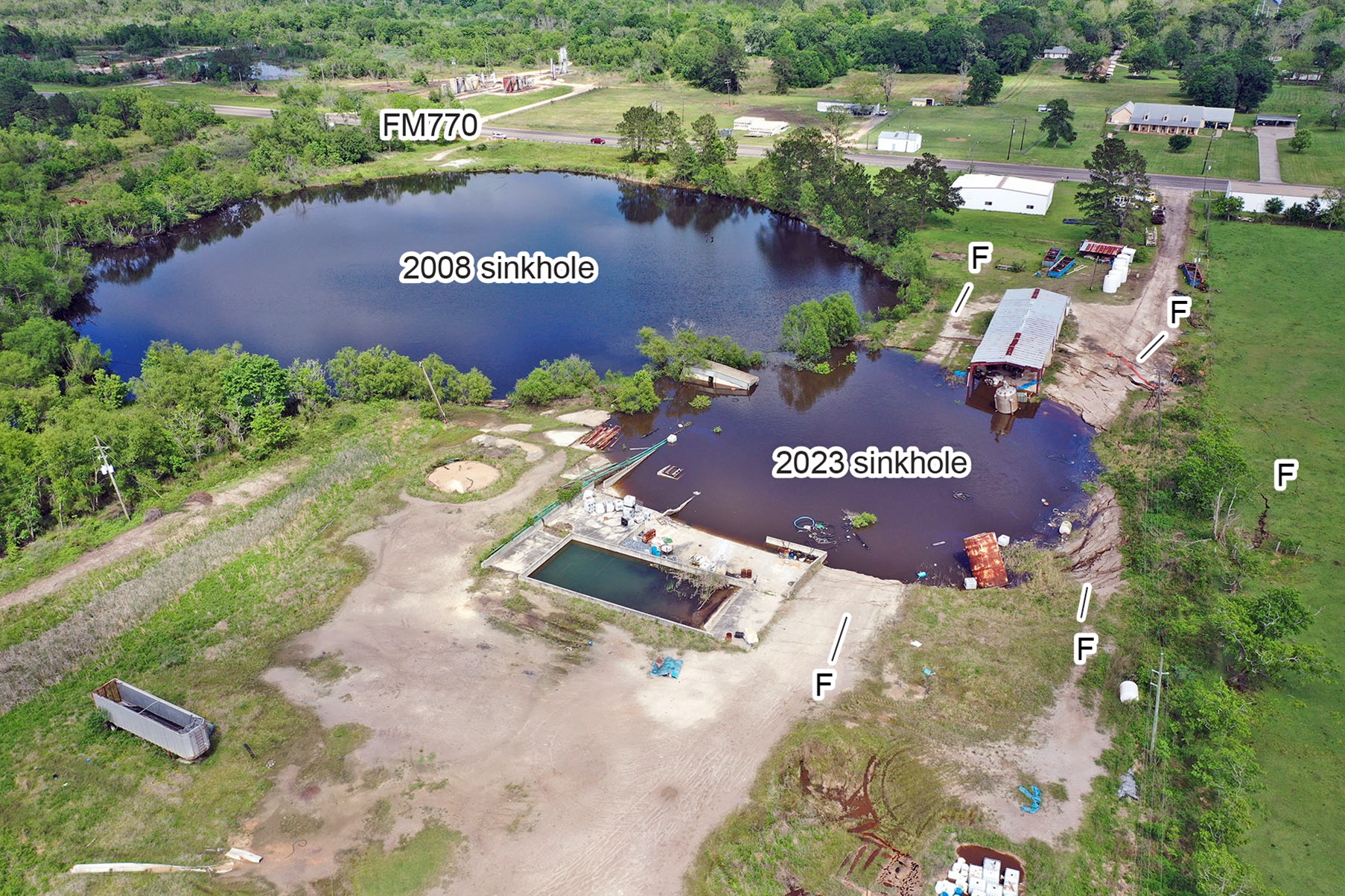
The first sinkhole in Daisetta appeared on the northwestern side of the salt dome in a matter of hours on May 7, 2008, swallowing a few oil tanks and several vehicles and growing larger than a football field and up to 60 ft (20 m) deep. Fifteen years later, the second sinkhole formed on April 8, 2023, leaving fissures (F) that threaten a commercial structure and a swimming pool. Production of oil and gas or oilfield fluid disposal into the caprock is thought to have contributed to sinkhole development, since salt is very soluble in water.
Credit: Jeff Paine, Bureau of Economic Geology

